East Asia, Southeast Asia, Austral Realm, Pacific Rim Report
VerifiedAdded on 2022/08/19
|8
|1707
|11
Report
AI Summary
This report delves into four key geographical areas: East Asia, Southeast Asia, Australia, and the Pacific Rim. It examines the rapid economic rise of East Asia, including Japan, China, North and South Korea, and the internal tensions that have accompanied this transformation. The report also analyzes the growing influence of China in Southeast Asia, exploring its impact on trade, geopolitics, and international relations, including its influence in India and Pakistan. Furthermore, it investigates how Australia's relative location in the Southern and Eastern Hemispheres is reshaping its global character and economic growth, particularly concerning its relationship with Papua New Guinea. Finally, the report assesses the impact of UNCLOS interventions on island nations within the Pacific realm, considering environmental concerns such as climate change, rising sea levels, and maritime boundaries, and the challenges faced by these island nations.
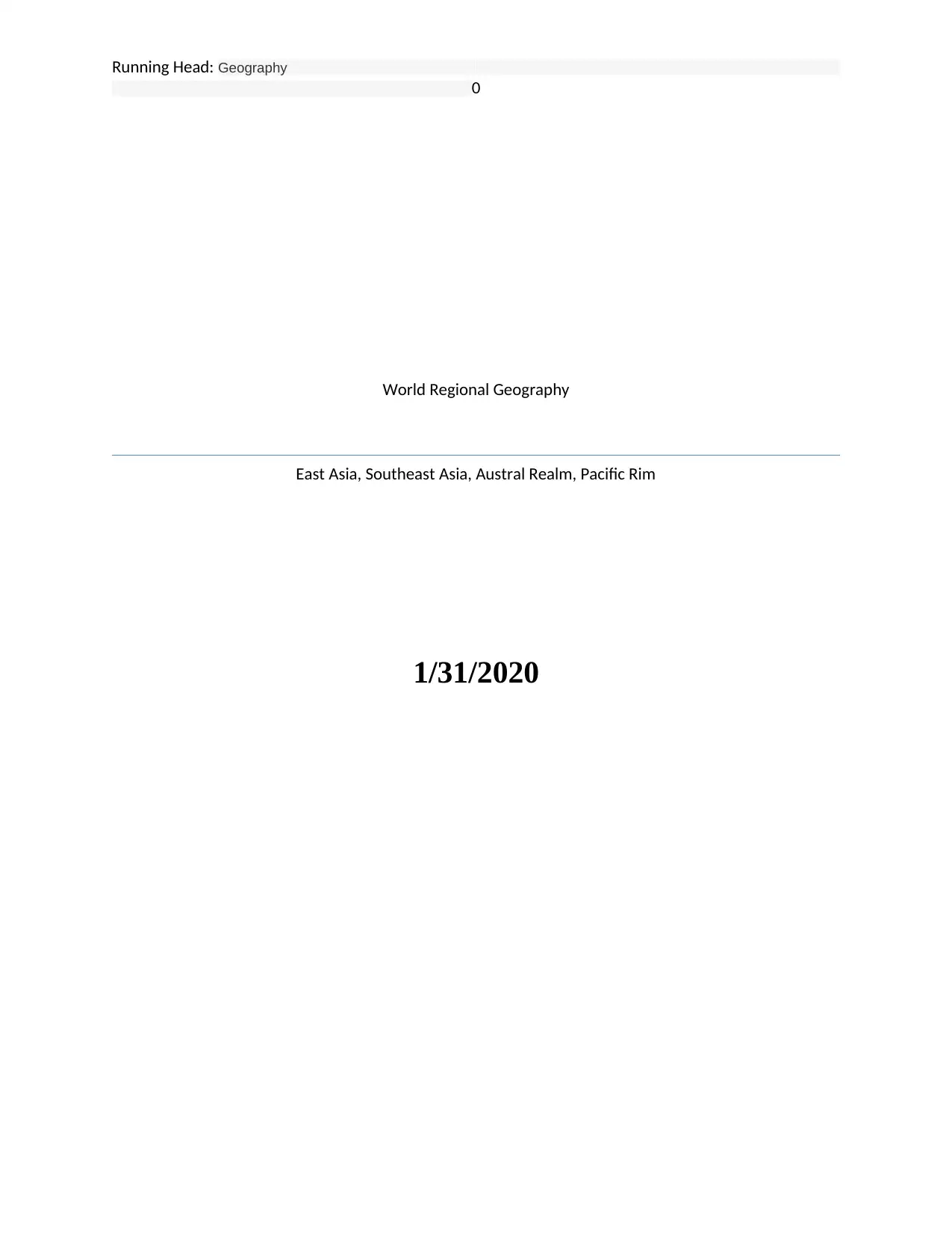
Running Head: Geography
0
World Regional Geography
East Asia, Southeast Asia, Austral Realm, Pacific Rim
1/31/2020
0
World Regional Geography
East Asia, Southeast Asia, Austral Realm, Pacific Rim
1/31/2020
Paraphrase This Document
Need a fresh take? Get an instant paraphrase of this document with our AI Paraphraser
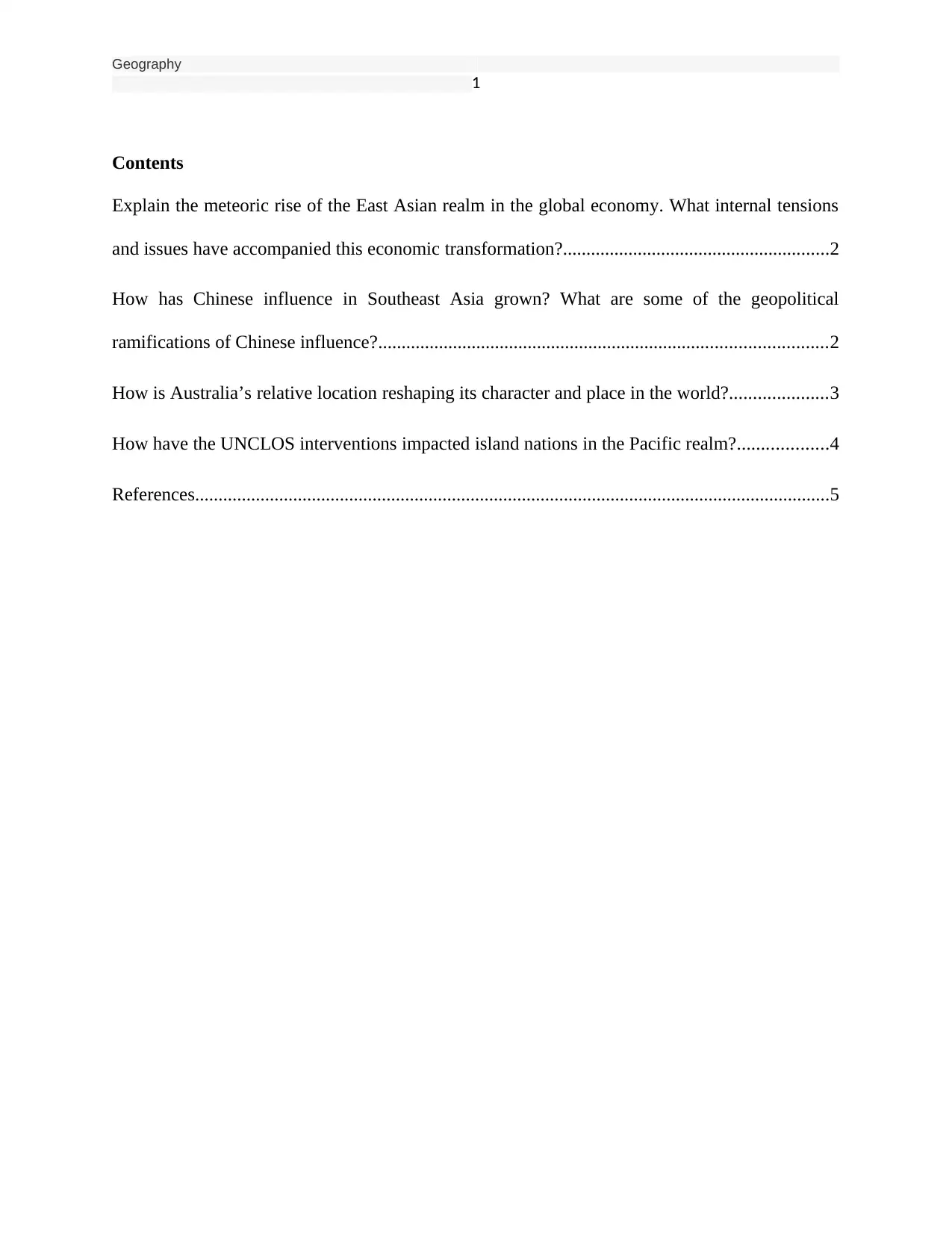
Geography
1
Contents
Explain the meteoric rise of the East Asian realm in the global economy. What internal tensions
and issues have accompanied this economic transformation?.........................................................2
How has Chinese influence in Southeast Asia grown? What are some of the geopolitical
ramifications of Chinese influence?................................................................................................2
How is Australia’s relative location reshaping its character and place in the world?.....................3
How have the UNCLOS interventions impacted island nations in the Pacific realm?...................4
References........................................................................................................................................5
1
Contents
Explain the meteoric rise of the East Asian realm in the global economy. What internal tensions
and issues have accompanied this economic transformation?.........................................................2
How has Chinese influence in Southeast Asia grown? What are some of the geopolitical
ramifications of Chinese influence?................................................................................................2
How is Australia’s relative location reshaping its character and place in the world?.....................3
How have the UNCLOS interventions impacted island nations in the Pacific realm?...................4
References........................................................................................................................................5
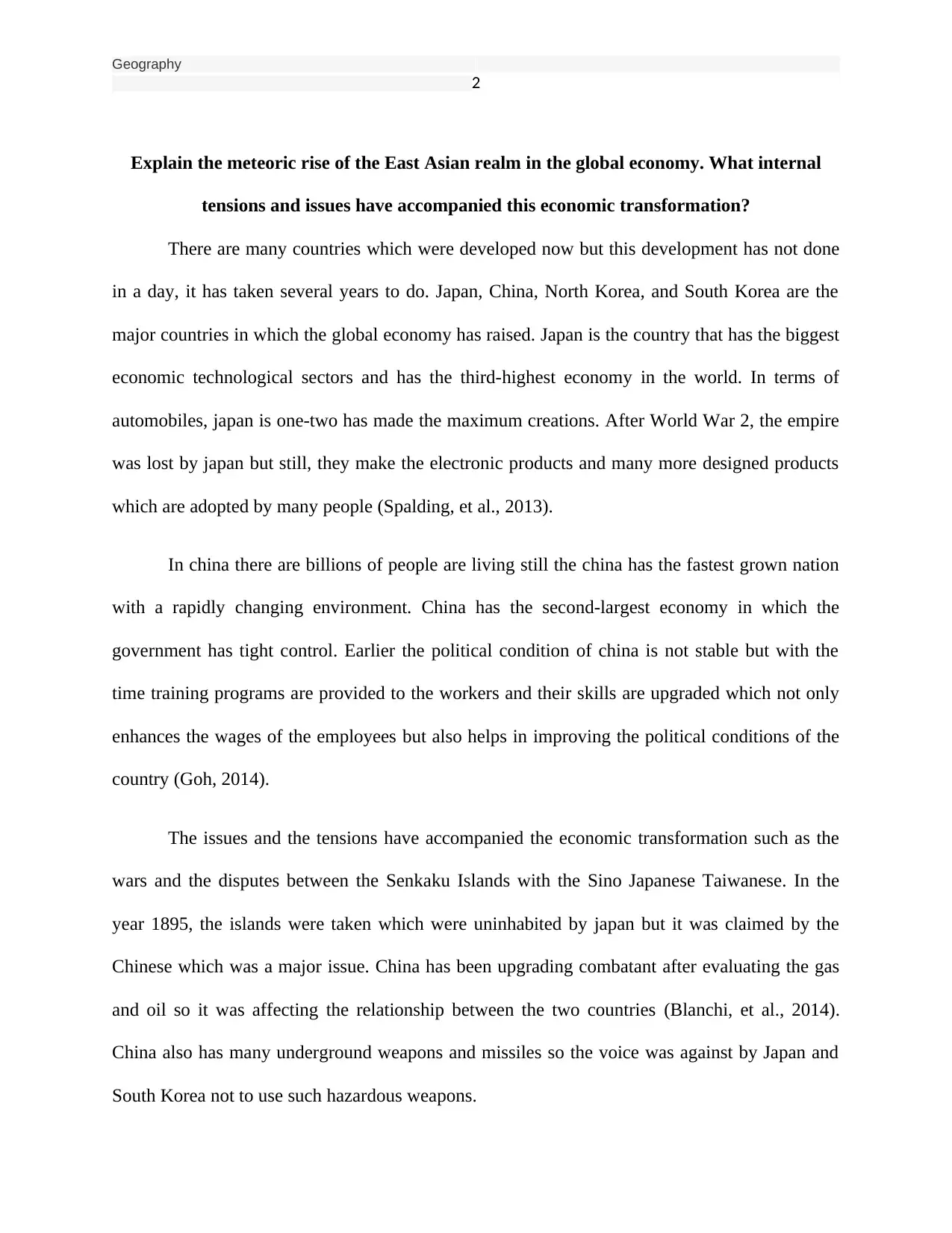
Geography
2
Explain the meteoric rise of the East Asian realm in the global economy. What internal
tensions and issues have accompanied this economic transformation?
There are many countries which were developed now but this development has not done
in a day, it has taken several years to do. Japan, China, North Korea, and South Korea are the
major countries in which the global economy has raised. Japan is the country that has the biggest
economic technological sectors and has the third-highest economy in the world. In terms of
automobiles, japan is one-two has made the maximum creations. After World War 2, the empire
was lost by japan but still, they make the electronic products and many more designed products
which are adopted by many people (Spalding, et al., 2013).
In china there are billions of people are living still the china has the fastest grown nation
with a rapidly changing environment. China has the second-largest economy in which the
government has tight control. Earlier the political condition of china is not stable but with the
time training programs are provided to the workers and their skills are upgraded which not only
enhances the wages of the employees but also helps in improving the political conditions of the
country (Goh, 2014).
The issues and the tensions have accompanied the economic transformation such as the
wars and the disputes between the Senkaku Islands with the Sino Japanese Taiwanese. In the
year 1895, the islands were taken which were uninhabited by japan but it was claimed by the
Chinese which was a major issue. China has been upgrading combatant after evaluating the gas
and oil so it was affecting the relationship between the two countries (Blanchi, et al., 2014).
China also has many underground weapons and missiles so the voice was against by Japan and
South Korea not to use such hazardous weapons.
2
Explain the meteoric rise of the East Asian realm in the global economy. What internal
tensions and issues have accompanied this economic transformation?
There are many countries which were developed now but this development has not done
in a day, it has taken several years to do. Japan, China, North Korea, and South Korea are the
major countries in which the global economy has raised. Japan is the country that has the biggest
economic technological sectors and has the third-highest economy in the world. In terms of
automobiles, japan is one-two has made the maximum creations. After World War 2, the empire
was lost by japan but still, they make the electronic products and many more designed products
which are adopted by many people (Spalding, et al., 2013).
In china there are billions of people are living still the china has the fastest grown nation
with a rapidly changing environment. China has the second-largest economy in which the
government has tight control. Earlier the political condition of china is not stable but with the
time training programs are provided to the workers and their skills are upgraded which not only
enhances the wages of the employees but also helps in improving the political conditions of the
country (Goh, 2014).
The issues and the tensions have accompanied the economic transformation such as the
wars and the disputes between the Senkaku Islands with the Sino Japanese Taiwanese. In the
year 1895, the islands were taken which were uninhabited by japan but it was claimed by the
Chinese which was a major issue. China has been upgrading combatant after evaluating the gas
and oil so it was affecting the relationship between the two countries (Blanchi, et al., 2014).
China also has many underground weapons and missiles so the voice was against by Japan and
South Korea not to use such hazardous weapons.
⊘ This is a preview!⊘
Do you want full access?
Subscribe today to unlock all pages.

Trusted by 1+ million students worldwide
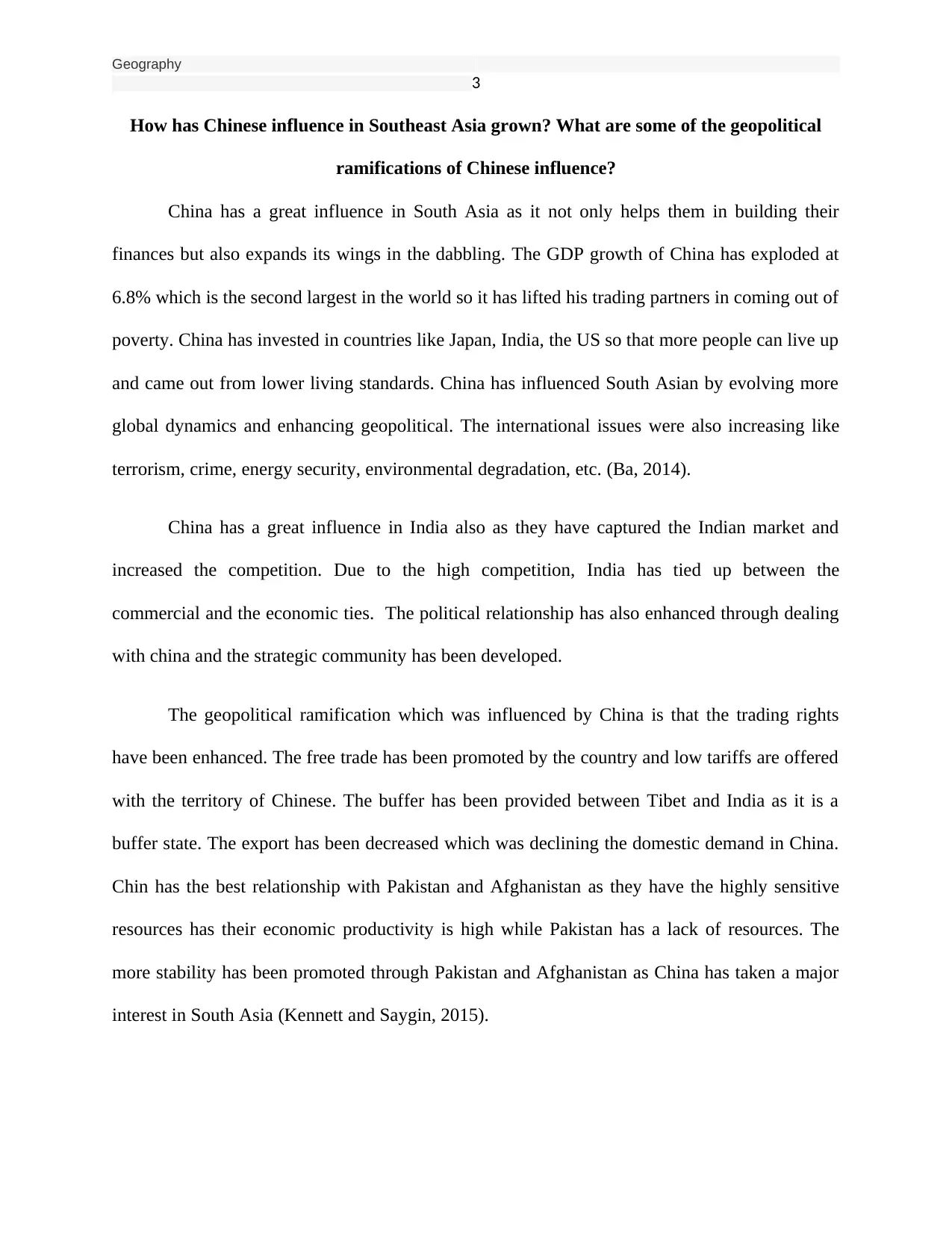
Geography
3
How has Chinese influence in Southeast Asia grown? What are some of the geopolitical
ramifications of Chinese influence?
China has a great influence in South Asia as it not only helps them in building their
finances but also expands its wings in the dabbling. The GDP growth of China has exploded at
6.8% which is the second largest in the world so it has lifted his trading partners in coming out of
poverty. China has invested in countries like Japan, India, the US so that more people can live up
and came out from lower living standards. China has influenced South Asian by evolving more
global dynamics and enhancing geopolitical. The international issues were also increasing like
terrorism, crime, energy security, environmental degradation, etc. (Ba, 2014).
China has a great influence in India also as they have captured the Indian market and
increased the competition. Due to the high competition, India has tied up between the
commercial and the economic ties. The political relationship has also enhanced through dealing
with china and the strategic community has been developed.
The geopolitical ramification which was influenced by China is that the trading rights
have been enhanced. The free trade has been promoted by the country and low tariffs are offered
with the territory of Chinese. The buffer has been provided between Tibet and India as it is a
buffer state. The export has been decreased which was declining the domestic demand in China.
Chin has the best relationship with Pakistan and Afghanistan as they have the highly sensitive
resources has their economic productivity is high while Pakistan has a lack of resources. The
more stability has been promoted through Pakistan and Afghanistan as China has taken a major
interest in South Asia (Kennett and Saygin, 2015).
3
How has Chinese influence in Southeast Asia grown? What are some of the geopolitical
ramifications of Chinese influence?
China has a great influence in South Asia as it not only helps them in building their
finances but also expands its wings in the dabbling. The GDP growth of China has exploded at
6.8% which is the second largest in the world so it has lifted his trading partners in coming out of
poverty. China has invested in countries like Japan, India, the US so that more people can live up
and came out from lower living standards. China has influenced South Asian by evolving more
global dynamics and enhancing geopolitical. The international issues were also increasing like
terrorism, crime, energy security, environmental degradation, etc. (Ba, 2014).
China has a great influence in India also as they have captured the Indian market and
increased the competition. Due to the high competition, India has tied up between the
commercial and the economic ties. The political relationship has also enhanced through dealing
with china and the strategic community has been developed.
The geopolitical ramification which was influenced by China is that the trading rights
have been enhanced. The free trade has been promoted by the country and low tariffs are offered
with the territory of Chinese. The buffer has been provided between Tibet and India as it is a
buffer state. The export has been decreased which was declining the domestic demand in China.
Chin has the best relationship with Pakistan and Afghanistan as they have the highly sensitive
resources has their economic productivity is high while Pakistan has a lack of resources. The
more stability has been promoted through Pakistan and Afghanistan as China has taken a major
interest in South Asia (Kennett and Saygin, 2015).
Paraphrase This Document
Need a fresh take? Get an instant paraphrase of this document with our AI Paraphraser
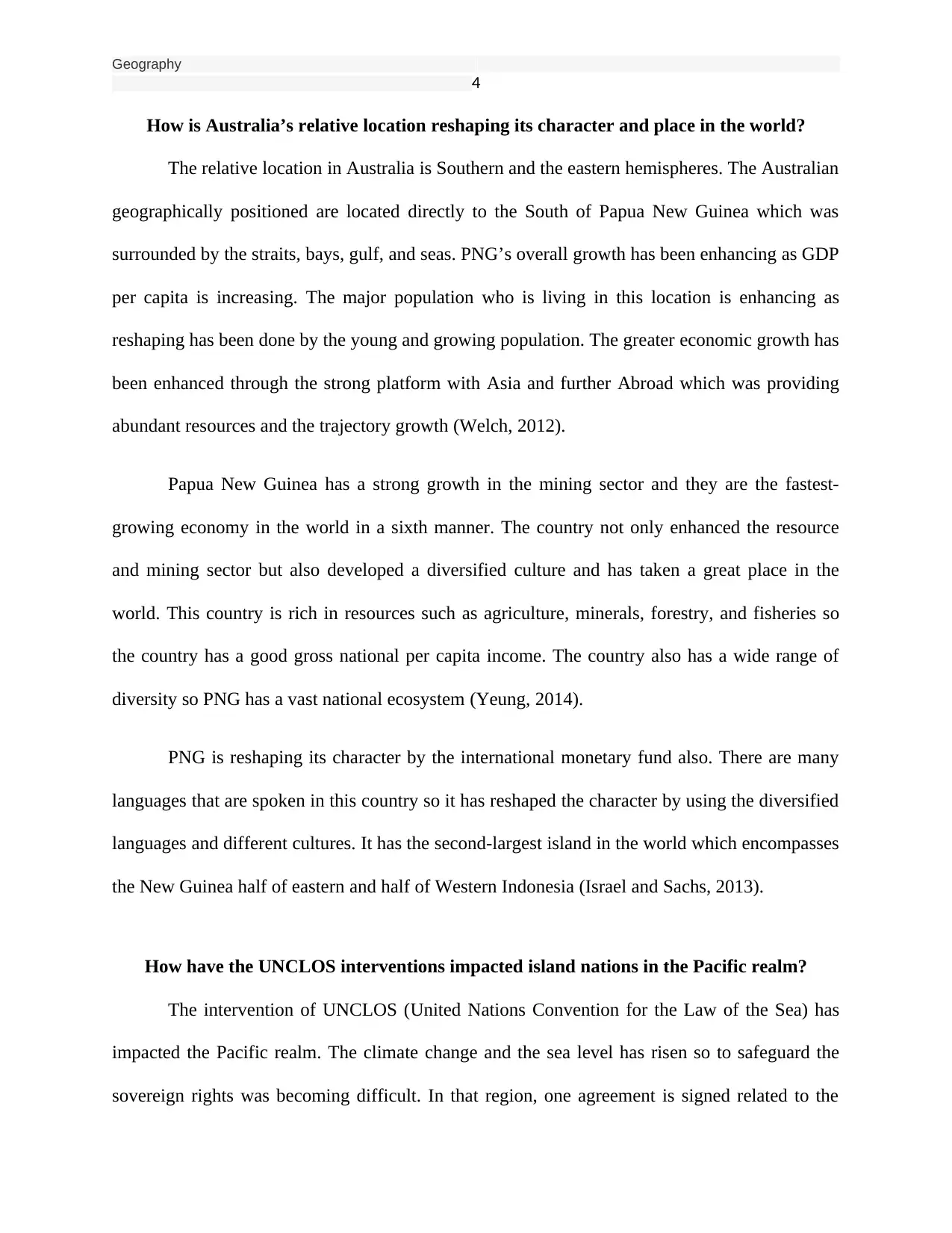
Geography
4
How is Australia’s relative location reshaping its character and place in the world?
The relative location in Australia is Southern and the eastern hemispheres. The Australian
geographically positioned are located directly to the South of Papua New Guinea which was
surrounded by the straits, bays, gulf, and seas. PNG’s overall growth has been enhancing as GDP
per capita is increasing. The major population who is living in this location is enhancing as
reshaping has been done by the young and growing population. The greater economic growth has
been enhanced through the strong platform with Asia and further Abroad which was providing
abundant resources and the trajectory growth (Welch, 2012).
Papua New Guinea has a strong growth in the mining sector and they are the fastest-
growing economy in the world in a sixth manner. The country not only enhanced the resource
and mining sector but also developed a diversified culture and has taken a great place in the
world. This country is rich in resources such as agriculture, minerals, forestry, and fisheries so
the country has a good gross national per capita income. The country also has a wide range of
diversity so PNG has a vast national ecosystem (Yeung, 2014).
PNG is reshaping its character by the international monetary fund also. There are many
languages that are spoken in this country so it has reshaped the character by using the diversified
languages and different cultures. It has the second-largest island in the world which encompasses
the New Guinea half of eastern and half of Western Indonesia (Israel and Sachs, 2013).
How have the UNCLOS interventions impacted island nations in the Pacific realm?
The intervention of UNCLOS (United Nations Convention for the Law of the Sea) has
impacted the Pacific realm. The climate change and the sea level has risen so to safeguard the
sovereign rights was becoming difficult. In that region, one agreement is signed related to the
4
How is Australia’s relative location reshaping its character and place in the world?
The relative location in Australia is Southern and the eastern hemispheres. The Australian
geographically positioned are located directly to the South of Papua New Guinea which was
surrounded by the straits, bays, gulf, and seas. PNG’s overall growth has been enhancing as GDP
per capita is increasing. The major population who is living in this location is enhancing as
reshaping has been done by the young and growing population. The greater economic growth has
been enhanced through the strong platform with Asia and further Abroad which was providing
abundant resources and the trajectory growth (Welch, 2012).
Papua New Guinea has a strong growth in the mining sector and they are the fastest-
growing economy in the world in a sixth manner. The country not only enhanced the resource
and mining sector but also developed a diversified culture and has taken a great place in the
world. This country is rich in resources such as agriculture, minerals, forestry, and fisheries so
the country has a good gross national per capita income. The country also has a wide range of
diversity so PNG has a vast national ecosystem (Yeung, 2014).
PNG is reshaping its character by the international monetary fund also. There are many
languages that are spoken in this country so it has reshaped the character by using the diversified
languages and different cultures. It has the second-largest island in the world which encompasses
the New Guinea half of eastern and half of Western Indonesia (Israel and Sachs, 2013).
How have the UNCLOS interventions impacted island nations in the Pacific realm?
The intervention of UNCLOS (United Nations Convention for the Law of the Sea) has
impacted the Pacific realm. The climate change and the sea level has risen so to safeguard the
sovereign rights was becoming difficult. In that region, one agreement is signed related to the
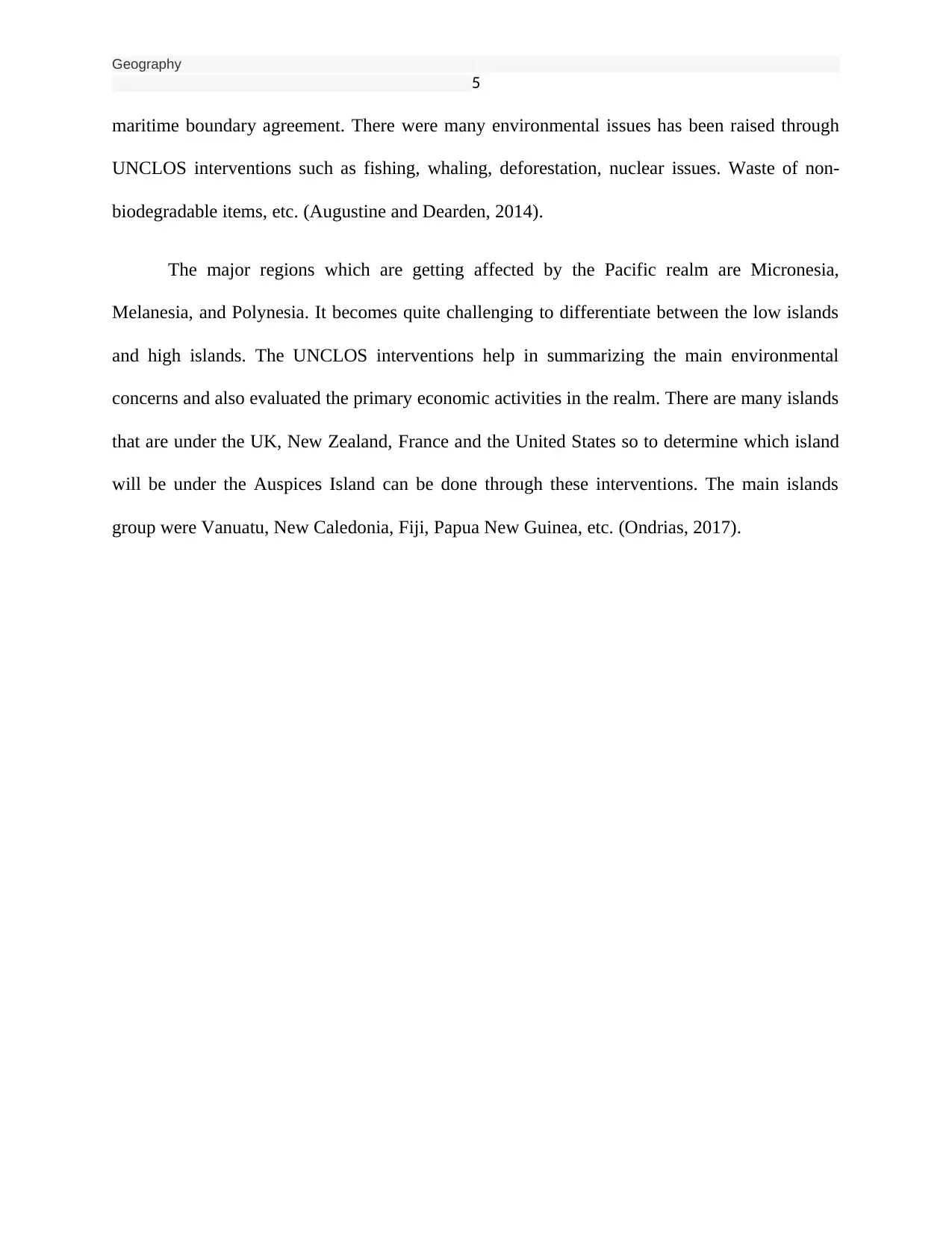
Geography
5
maritime boundary agreement. There were many environmental issues has been raised through
UNCLOS interventions such as fishing, whaling, deforestation, nuclear issues. Waste of non-
biodegradable items, etc. (Augustine and Dearden, 2014).
The major regions which are getting affected by the Pacific realm are Micronesia,
Melanesia, and Polynesia. It becomes quite challenging to differentiate between the low islands
and high islands. The UNCLOS interventions help in summarizing the main environmental
concerns and also evaluated the primary economic activities in the realm. There are many islands
that are under the UK, New Zealand, France and the United States so to determine which island
will be under the Auspices Island can be done through these interventions. The main islands
group were Vanuatu, New Caledonia, Fiji, Papua New Guinea, etc. (Ondrias, 2017).
5
maritime boundary agreement. There were many environmental issues has been raised through
UNCLOS interventions such as fishing, whaling, deforestation, nuclear issues. Waste of non-
biodegradable items, etc. (Augustine and Dearden, 2014).
The major regions which are getting affected by the Pacific realm are Micronesia,
Melanesia, and Polynesia. It becomes quite challenging to differentiate between the low islands
and high islands. The UNCLOS interventions help in summarizing the main environmental
concerns and also evaluated the primary economic activities in the realm. There are many islands
that are under the UK, New Zealand, France and the United States so to determine which island
will be under the Auspices Island can be done through these interventions. The main islands
group were Vanuatu, New Caledonia, Fiji, Papua New Guinea, etc. (Ondrias, 2017).
⊘ This is a preview!⊘
Do you want full access?
Subscribe today to unlock all pages.

Trusted by 1+ million students worldwide
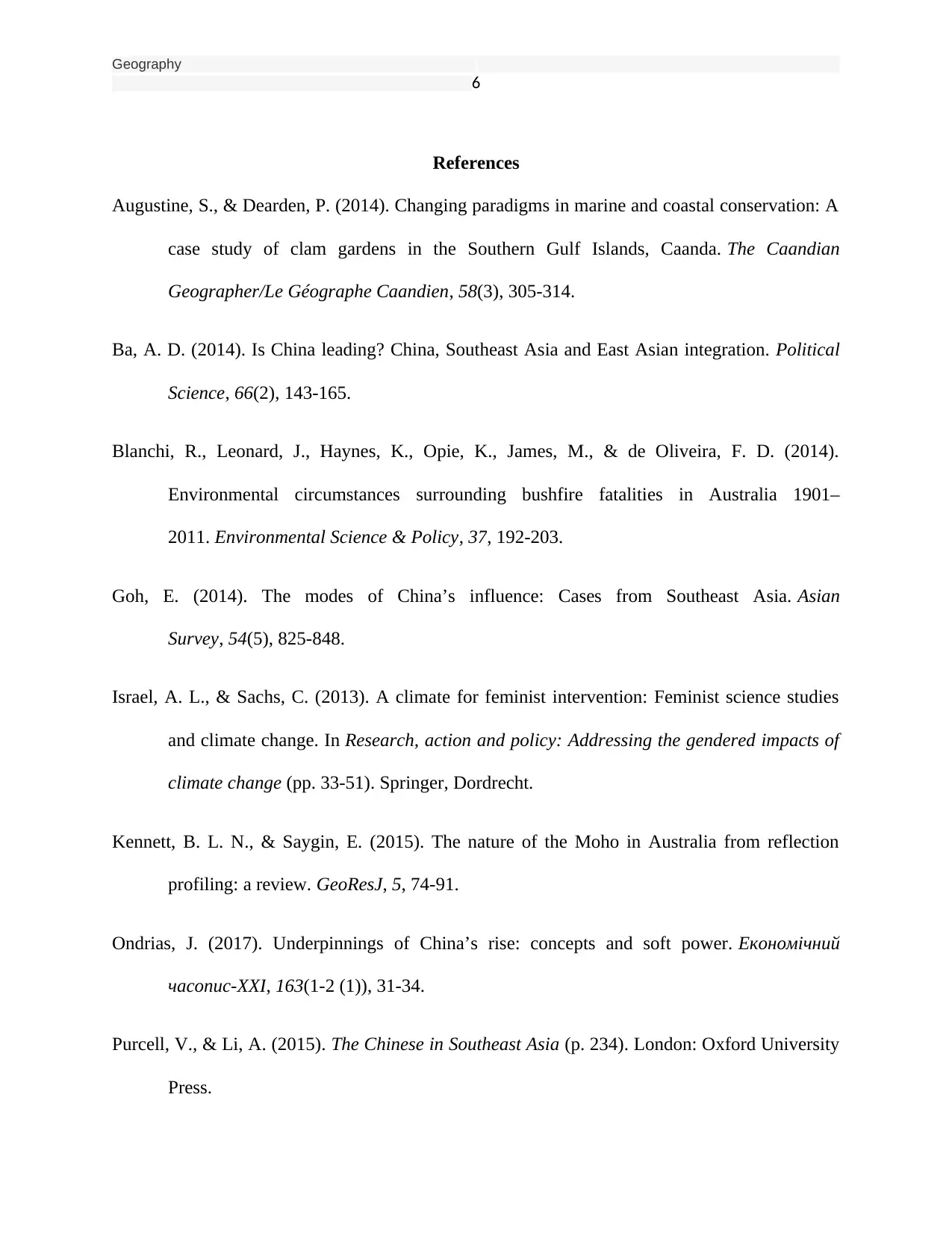
Geography
6
References
Augustine, S., & Dearden, P. (2014). Changing paradigms in marine and coastal conservation: A
case study of clam gardens in the Southern Gulf Islands, Caanda. The Caandian
Geographer/Le Géographe Caandien, 58(3), 305-314.
Ba, A. D. (2014). Is China leading? China, Southeast Asia and East Asian integration. Political
Science, 66(2), 143-165.
Blanchi, R., Leonard, J., Haynes, K., Opie, K., James, M., & de Oliveira, F. D. (2014).
Environmental circumstances surrounding bushfire fatalities in Australia 1901–
2011. Environmental Science & Policy, 37, 192-203.
Goh, E. (2014). The modes of China’s influence: Cases from Southeast Asia. Asian
Survey, 54(5), 825-848.
Israel, A. L., & Sachs, C. (2013). A climate for feminist intervention: Feminist science studies
and climate change. In Research, action and policy: Addressing the gendered impacts of
climate change (pp. 33-51). Springer, Dordrecht.
Kennett, B. L. N., & Saygin, E. (2015). The nature of the Moho in Australia from reflection
profiling: a review. GeoResJ, 5, 74-91.
Ondrias, J. (2017). Underpinnings of China’s rise: concepts and soft power. Економічний
часопис-ХХІ, 163(1-2 (1)), 31-34.
Purcell, V., & Li, A. (2015). The Chinese in Southeast Asia (p. 234). London: Oxford University
Press.
6
References
Augustine, S., & Dearden, P. (2014). Changing paradigms in marine and coastal conservation: A
case study of clam gardens in the Southern Gulf Islands, Caanda. The Caandian
Geographer/Le Géographe Caandien, 58(3), 305-314.
Ba, A. D. (2014). Is China leading? China, Southeast Asia and East Asian integration. Political
Science, 66(2), 143-165.
Blanchi, R., Leonard, J., Haynes, K., Opie, K., James, M., & de Oliveira, F. D. (2014).
Environmental circumstances surrounding bushfire fatalities in Australia 1901–
2011. Environmental Science & Policy, 37, 192-203.
Goh, E. (2014). The modes of China’s influence: Cases from Southeast Asia. Asian
Survey, 54(5), 825-848.
Israel, A. L., & Sachs, C. (2013). A climate for feminist intervention: Feminist science studies
and climate change. In Research, action and policy: Addressing the gendered impacts of
climate change (pp. 33-51). Springer, Dordrecht.
Kennett, B. L. N., & Saygin, E. (2015). The nature of the Moho in Australia from reflection
profiling: a review. GeoResJ, 5, 74-91.
Ondrias, J. (2017). Underpinnings of China’s rise: concepts and soft power. Економічний
часопис-ХХІ, 163(1-2 (1)), 31-34.
Purcell, V., & Li, A. (2015). The Chinese in Southeast Asia (p. 234). London: Oxford University
Press.
Paraphrase This Document
Need a fresh take? Get an instant paraphrase of this document with our AI Paraphraser
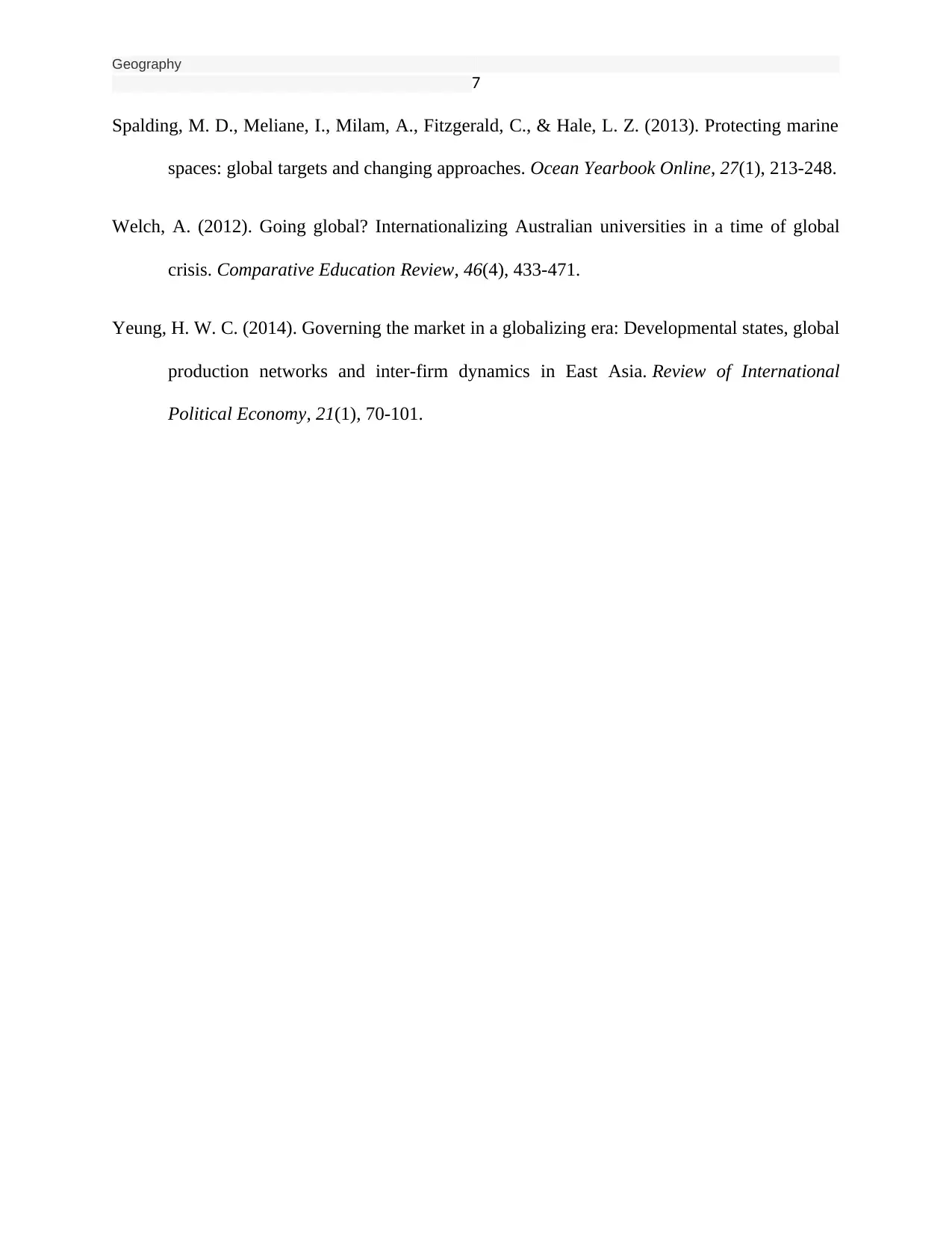
Geography
7
Spalding, M. D., Meliane, I., Milam, A., Fitzgerald, C., & Hale, L. Z. (2013). Protecting marine
spaces: global targets and changing approaches. Ocean Yearbook Online, 27(1), 213-248.
Welch, A. (2012). Going global? Internationalizing Australian universities in a time of global
crisis. Comparative Education Review, 46(4), 433-471.
Yeung, H. W. C. (2014). Governing the market in a globalizing era: Developmental states, global
production networks and inter-firm dynamics in East Asia. Review of International
Political Economy, 21(1), 70-101.
7
Spalding, M. D., Meliane, I., Milam, A., Fitzgerald, C., & Hale, L. Z. (2013). Protecting marine
spaces: global targets and changing approaches. Ocean Yearbook Online, 27(1), 213-248.
Welch, A. (2012). Going global? Internationalizing Australian universities in a time of global
crisis. Comparative Education Review, 46(4), 433-471.
Yeung, H. W. C. (2014). Governing the market in a globalizing era: Developmental states, global
production networks and inter-firm dynamics in East Asia. Review of International
Political Economy, 21(1), 70-101.
1 out of 8
Related Documents
Your All-in-One AI-Powered Toolkit for Academic Success.
+13062052269
info@desklib.com
Available 24*7 on WhatsApp / Email
![[object Object]](/_next/static/media/star-bottom.7253800d.svg)
Unlock your academic potential
Copyright © 2020–2025 A2Z Services. All Rights Reserved. Developed and managed by ZUCOL.



